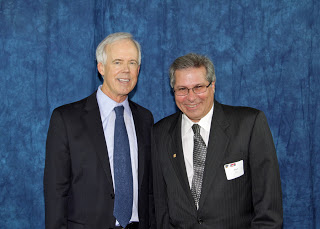“Three of the Top Workplace
Stressors”
“A true leader has the
confidence to influence change, the courage to make tough decisions, and the
compassion to listen to the needs of others. He does not set out to be a
leader, but becomes one by the equality of his actions and the integrity of his
intent.” – General Douglas MacArthur
The most powerful form of influence we can exert as leaders is… “the ability to
influence change.” Yet when change is produced it creates emotions and fears
among the members of the organization.
Change is stressful. But stress is a stimulus that can be positive or negative.
Studies have shown that stress in the workplace most commonly occurs in one of
three situations:
1. When there is a high demand placed on employees
2. When employees are being closely watched
3. When employees are concerned about their competence or value
As leaders it is our job to quell those fears. When we operate in the
management role we must balance our passion, execution and sensitivity. It is
good to be passionate about where we are taking our organization. But even more
important is translating this belief into action. Taking part in the execution
process makes a big statement to your team. The best generals have led their
troops into battle at the FRONT of the lines. You won’t win cooperation by
calling the plays from the sidelines. This will create resentment and reduce
morale. Finally be sensitive to the emotional and behavioral issues involved in
change. Get in touch with how the change is affecting each of the critical
members of your organization.
In order to truly put these precepts into practice, we need to understand
the way change works. Jeanie Daniel Duck in her book, “The Change
Monster,” points-out the stages of organizational change and how this
impacts the people in companies.
The stages of change are as follows:
1. Stagnation
2. Preparation
3. Implementation
4. Determination
5. Fruition
Stage 1: Stagnation
This first phase can be summed up in two words: demoralization and
denial. A demoralized company exhibits the same symptoms as a depressed person:
general slowness, difficulty in making decisions, and a lack of motivation.
Stagnation can be caused by poor communication, lack of leadership, murky
strategy, too few resources, conflicting goals or poor execution. Before you
can implement a sound strategy, however, you have to modify the culture of the
company – its beliefs, attitudes and habits. In most cases these are the
elements hindering growth. To burst free of stagnation, you need to ask
yourself: “What outdated beliefs and behaviors are preventing us from
conceiving or executing a winning strategy?”
Stage 2: Preparation
During this stage, many operational issues are addressed. This
often results in a new structure for the organization, new employee roles. New
responsibilities are designed, and management determines which products or services
will be most critical in the future. The goal in this stage is to align and
energize our management team around a corporate strategy and vision. As leaders
we must all consistently articulate the SAME vision. In other words, we all
need to be on the same page as to where we’re going and how we plan on getting
there. Only then will it be clearly understood and executed by others. We also
need to be careful of becoming too dictatorial with our precepts. The goal is
to develop a group thinking about change. This can’t happen if the leader isn’t
open to hearing criticism of his or her ideas.
Stage 3: Implementation
Implementation is different in every organization. Leaders are
responsible during the implementation phase for managing expectations, energy and
experience. Asking people to change can create resentment, embarrassment and
tension. Here are some ideas to reduce the barriers to change among team
members:
Test before deployment – If a new process is being implemented, try it in one
department or with one product or service group before rolling it out.
Build behavior first – Focus on a SINGLE OBJECTIVE and ask the
employees for input. This allows us to empower our team by letting them SHOW
YOU how they can come up with the solution. Create your own little focus groups if necessary for green-light
thinking.
Plan replication – Duplicate your successes. Transferring change
from person to person takes time. Let change spread rather than forcing it on
your team.
Stage 4: Determination
Because change does take time, many of the former champions of
change may have developed second thoughts. At this time it is not unusual to
see conflicts arise as a result of change. Often service levels drop, sales
falter, production problems deepen, and profitability wavers. It is critical
that leaders have the determination to see change through. We can be tempted to
throw up our hands and say, “That’s it! We’re going back to the way it
was. Nobody is doing what we told them to do!” Don’t mistake your own
perceptions for reality. People are finding a new way to accomplish their
goals. One that is more dependent on their efforts rather than their leaders
support. Conflict is not necessarily bad. It produces change, a reorganization
of priorities and self-sufficiency. Conflict must be facilitated in a
constructive way.
Stage 5: Fruition
No change is easy. But achieving long-sought-after goals is
rewarding. Once a targeted goal is reached, success often begets success. This
is the time to reward people for their success. Reward in public and punish in
private. The great Dale Carnegie said, “Praise the slightest improvement
and praise every improvement. Be hearty in your approbation and lavish in your
praise.”
Understanding the stages of change will afford leaders the ability
to assist their employee in dealing with the stress that change produces. As
effective leaders we must foster behaviors which are consistent with the
company’s values and objectives. Doing this in an organization experiencing
significant change is an audacious
Dale Carnegie customized corporate solutions provides all of the tools that
leaders need to deal with change in organizations. These include behavioral and
work competency assessments, strategic planning and succession planning systems
and leadership and employee engagement programs.
Give us a call to discover how you might be able to deal with
change more effectively.



